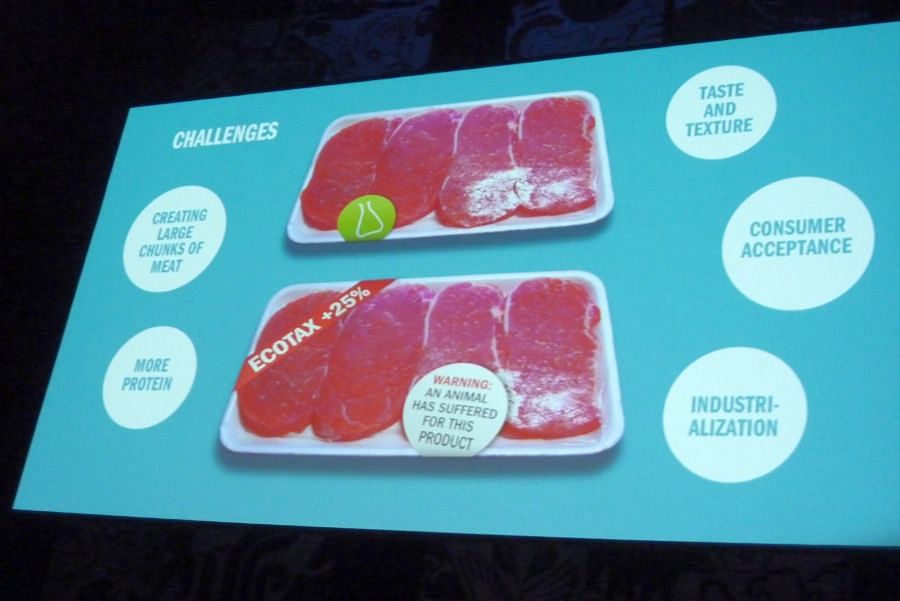
Imagine biting into a juicy, but cruelty-free, chicken burger. And with far fewer natural resources used as compared to factory farming.
This might sound too good to be true now, but it could happen very soon. Several start-ups and scientific and research institutions are doing research on lab-grown meat, which is also called clean meat and cultured meat.
What is lab-grown meat? It is meat grown under controlled conditions in a laboratory. Tissue cells are collected from animals, grown in vitro and it then begins to grow into what we are used to seeing as raw meat from slaughtered animals. Currently, beef, poultry, pork and seafood are being grown in labs.
U.S. companies and start-ups like Memphis Meats (founded by Indian-origin Uma Valeti), Mosa Meat, SuperMeat and Finless Foods have been at it for a few years now.
Recently, the Humane Society International (India), CSIR’s Centre for Cellular and Molecular Biology and National Research Centre on Meat have embarked on a project to produce clean meat. This project is being funded by the Union Government’s Department of Biotechnology.
“CCMB has received funding for their cell-based meat project by the Department of Biotechnology in April. This grant was one of the largest government funds allocated for cell-based meat research in the world. This is for the first two years of CCMB's cell-based meat project,” HSI India told Deccan Herald.
Analysts estimate that lab-grown meat could be in supermarket shelves by 2025 or so.
But, what is the problem with the meat we are eating now?
The most obvious is the extreme cruelty that animals have to suffer, whether it is in the rearing, transport or during slaughter.
“Cell-based meat is being hailed by animal welfare groups across the world for its ability to exponentially reduce animal suffering. This will replace billions of animals enduring a significant amount of pain in intensive animal agriculture with production systems that require a handful number of cells extracted from the animal without causing it any harm,” HSI India added.
“It will dramatically reduce both the number of animals involved in the production (as each sample of cells can create a far greater amount of meat when compared to conventionally produced meat) and the scale of pain, by eliminating intensive confinement and slaughter of animals. Cell-based meat would require a donor herd to be maintained, whose welfare can be far more easily protected due to their reduced numbers, compared to conventional housing systems for animals raised for meat,” it added.
The second problem is the amount of natural resources, like water and food, the animals must be fed in industrialised factory farming.
“The production of meat, dairy and eggs are increasingly being criticised for its lack of sustainability. Animal agriculture is a resource-intensive, environmentally degrading system which makes enormous contributions to greenhouse gas emissions, land and water contamination, deforestation, among other environmental challenges. While the environmental impact of cell-based meat currently predominantly relies on estimations of scaled-up versions of cell-based meat production, life cycle analyses of cell-based meat have predicted that cell-based meat production would require vastly reduced resource requirements, and, in comparison to conventionally produced meat will be more sustainable,” said HSI India.
“Additionally, cell-based meat has the potential to boost food security and safety. Food borne illnesses such as salmonella, E coli are a major public hazard in conventional meat. The sterile and controlled environment that cell-based meat will be produced in will significantly reduce the risk of contamination,” it added.
A study on environmental impacts of factory farming by the Pace University (New York) found that “it is a major contributor to water and air pollution as well as deforestation.
“The animals produce more than 1 million tons of manure every day. This animal waste often contains undigested antibiotics and when this waste is dumped in open ground, it can contaminate local water supplies.
“The animals release methane gas during digestion and these factory farms serve as concentrated sources of methane gas emissions.”
The United Nations Food and Agriculture Organisation has observed that “livestock farming accounts for 14.5 per cent of our global greenhouse gas emissions, more than the global transport sector”.
It appears a bit strange that it took us a very long time to actually get to the stage when edible burger patties are being ‘test-eaten’ by chefs. This is considering that in 1931, Winston Churchill had famously said: "We shall escape the absurdity of growing a whole chicken in order to eat the breast or wing, by growing these parts separately under a suitable medium."
In 1971, Russell Ross, an American professor of pathology, had attempted growing meat in a lab. From the 1990s, several attempts were being made to grow meat in labs.
It was a red-letter day on August 5, 2013, when the world’s lab-grown burger was cooked by noted chef Richard McGeown and tasted by critics Hanni Rutzler and Josh Schonwald. The patty was lab-grown by scientists from the Maastricht University (the Netherlands) with stem cells taken from a cow. This formed the basis for strips of muscle tissue, which were used to make the patty, which cost just over $ 300,000 to produce. The critics found the patty too dry due to the absence of fat.
The price of one patty is about $10 now.
In fact, there are several videos online in which general public in America is interviewed and they were averse to the idea of their food being grown in a lab.
But, this might just be initial resistance to a new idea. Over and above this, there is thought in some quarters that lab-grown meat will not solve environmental and food problems.
However, a Harvard Business Review report says that food demand is expected to increase anywhere between 59 and 98 per cent by 2050. Now, this is food for thought. It might be time to give initiatives like lab-grown meat a chance.